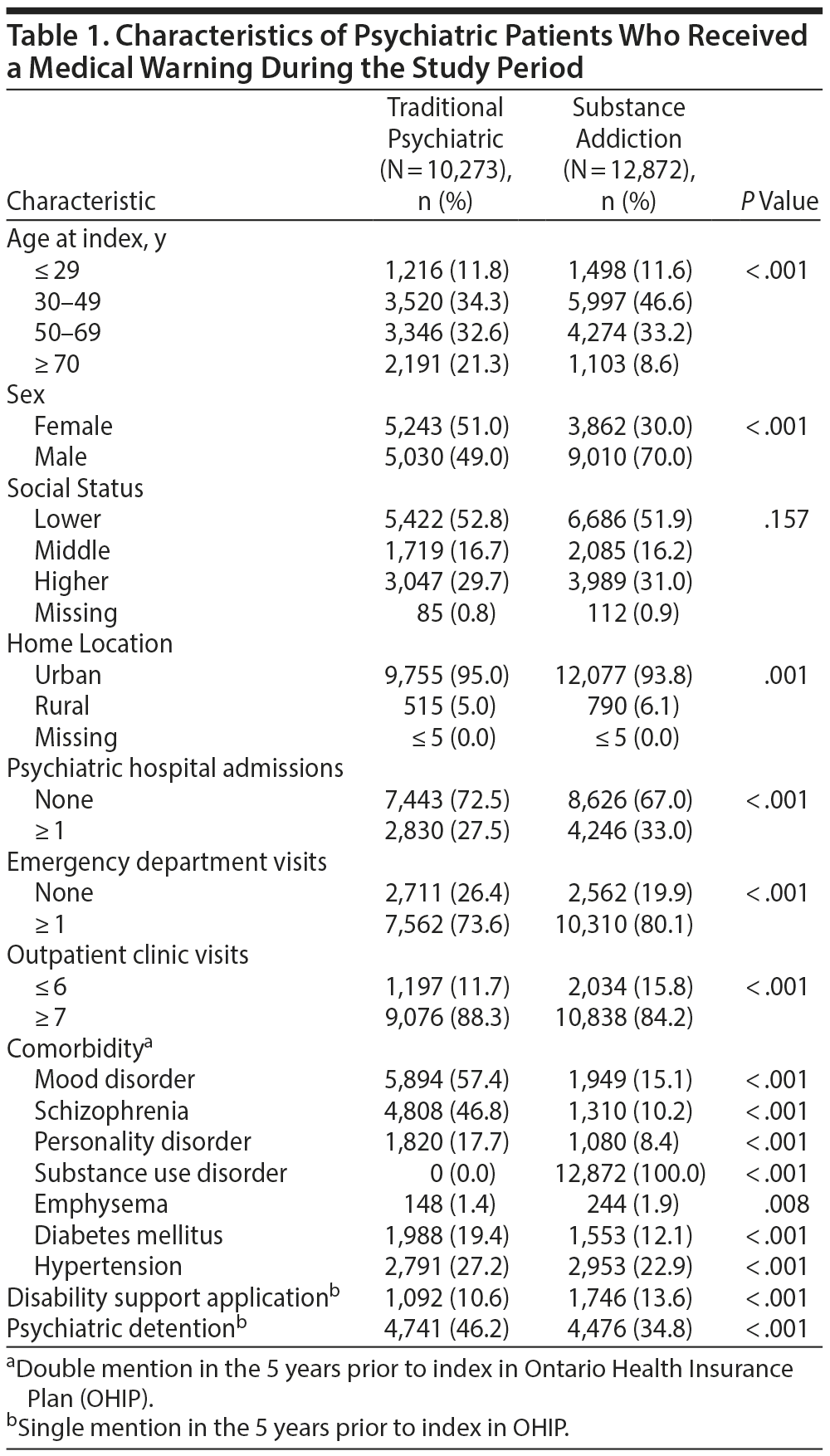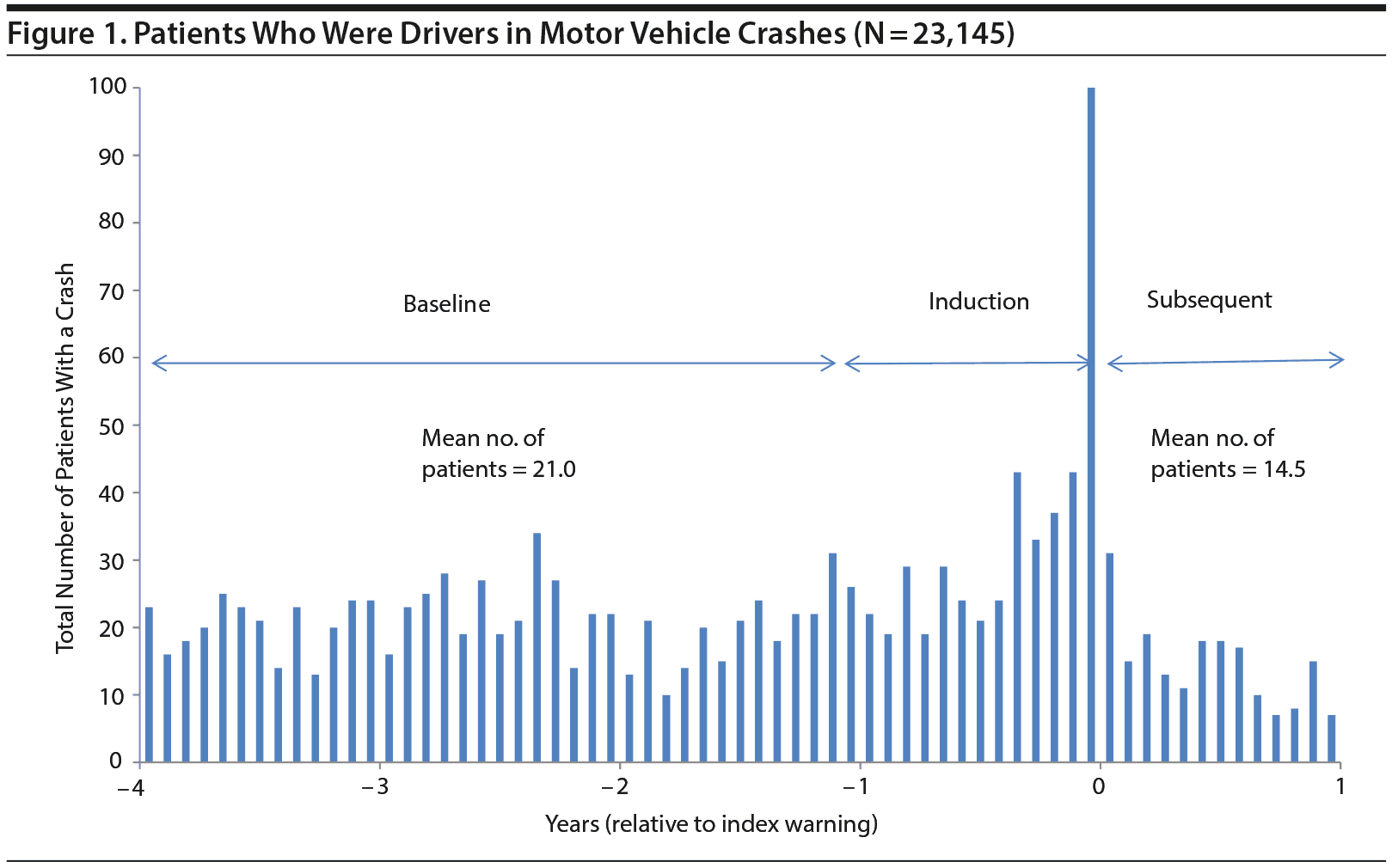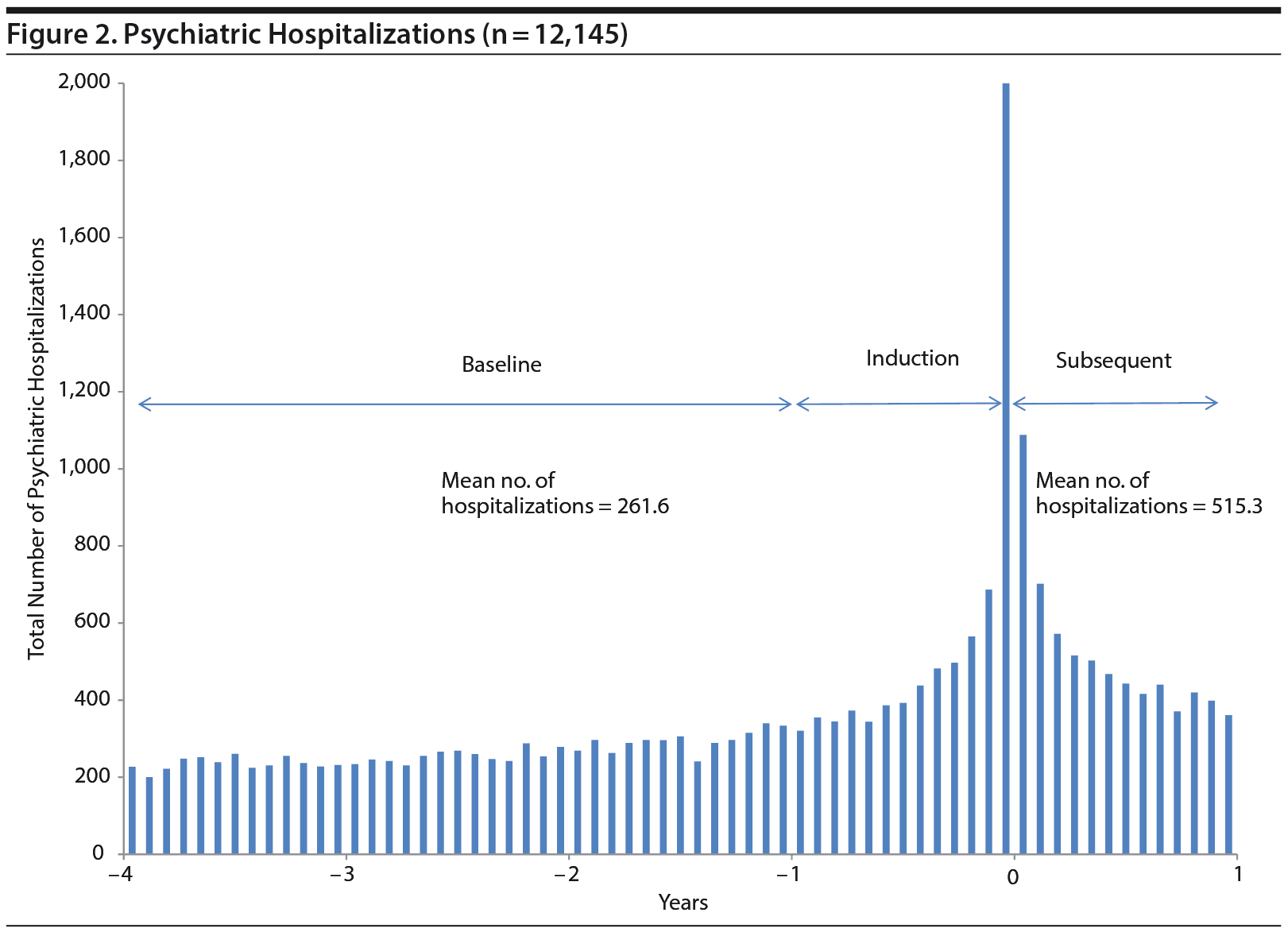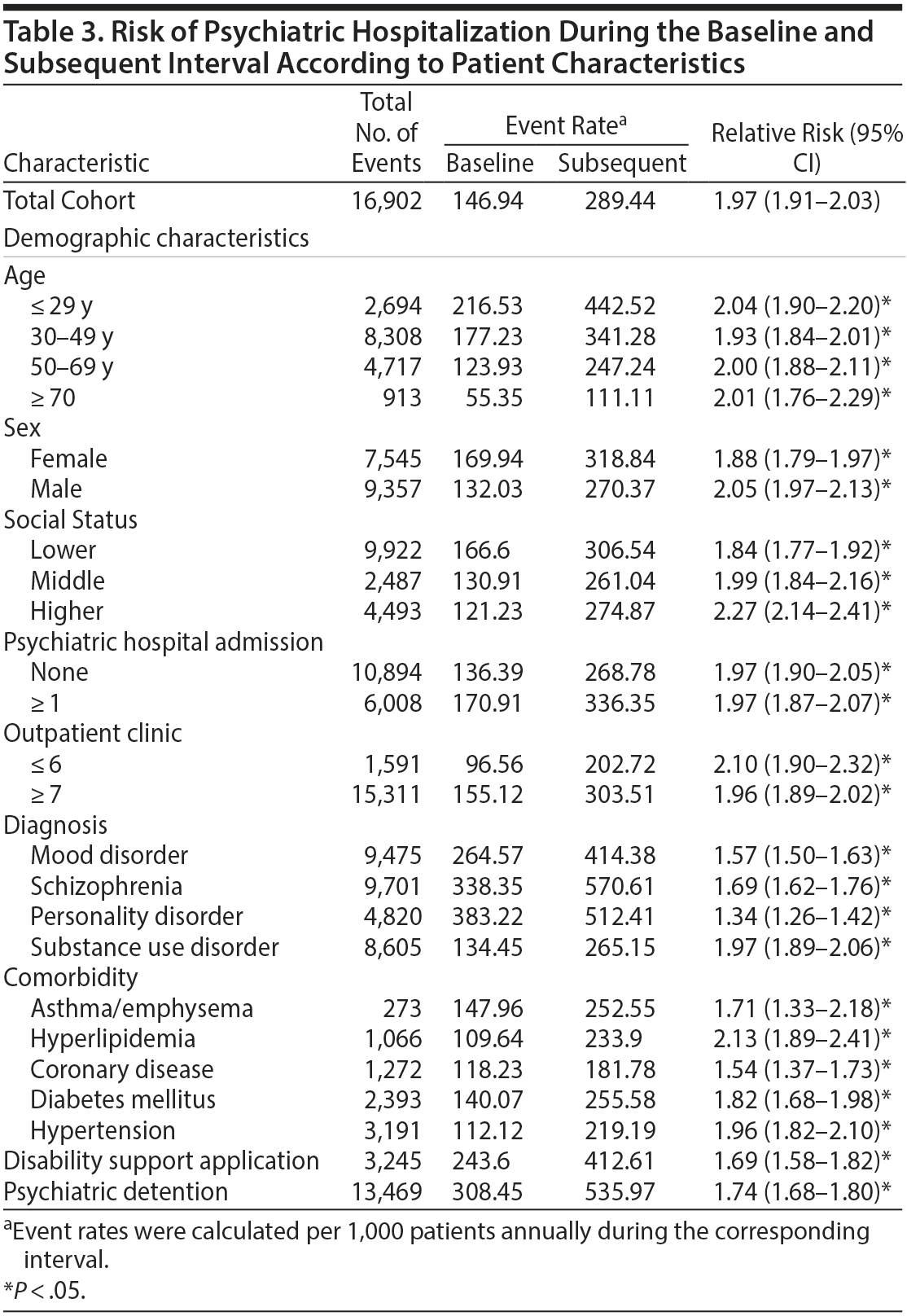Objective: To determine if physician warnings to psychiatric patients alter the subsequent frequency of a motor vehicle crash. A secondary objective was to determine if physician warnings change the subsequent frequency of psychiatric hospitalization.
Methods: Exposure crossover design of 23,145 psychiatric patients diagnosed with ICD-9 schizophrenia (code 295), mood disorder (296), personality disorder (301), or substance use disorder (303, 304) and warned by their physician about driving safety between April 1, 2006, and March 31, 2011. Each patient was followed for 4 years before the warning and 1 year after the warning. Patients living outside the region or lacking a valid health card number were excluded.
Results: Patients’ motor vehicle crash frequency decreased from 11.78 to 8.17 events per 1,000 patients per year after a physician warning, which corresponded to a relative risk of 0.69 (95% CI, 0.59-0.81; P < .001). Psychiatric hospitalization frequency increased from 147 to 289 events per 1,000 patients per year corresponding to a relative risk of 1.97 (95% CI, 1.91-2.03; P < .001).
Conclusions: Physician warnings are associated with a subsequent decreased frequency of motor vehicle crashes and increased frequency of psychiatric hospitalization. This result suggests that physician warnings are an effective intervention for reducing road trauma but need to be weighed against potential adverse psychiatric health.
Physician Warnings in Psychiatry and the Risk of Road Trauma:
An Exposure Crossover Study

ABSTRACT
Objective: To determine if physician warnings to psychiatric patients alter the subsequent frequency of a motor vehicle crash. A secondary objective was to determine if physician warnings change the subsequent frequency of psychiatric hospitalization.
Methods: Exposure crossover design of 23,145 psychiatric patients diagnosed with ICD-9 schizophrenia (code 295), mood disorder (296), personality disorder (301), or substance use disorder (303, 304) and warned by their physician about driving safety between April 1, 2006, and March 31, 2011. Each patient was followed for 4 years before the warning and 1 year after the warning. Patients living outside the region or lacking a valid health card number were excluded.
Results: Patients’ motor vehicle crash frequency decreased from 11.78 to 8.17 events per 1,000 patients per year after a physician warning, which corresponded to a relative risk of 0.69 (95% CI, 0.59-0.81; P < .001). Psychiatric hospitalization frequency increased from 147 to 289 events per 1,000 patients per year corresponding to a relative risk of 1.97 (95% CI, 1.91-2.03; P < .001).
Conclusions: Physician warnings are associated with a subsequent decreased frequency of motor vehicle crashes and increased frequency of psychiatric hospitalization. This result suggests that physician warnings are an effective intervention for reducing road trauma but need to be weighed against potential adverse psychiatric health.
J Clin Psychiatry 2016;77(10):e1256-e1261
dx.doi.org/10.4088/JCP.15m10224
© Copyright 2016 Physicians Postgraduate Press, Inc.
aDepartment of Psychiatry, University of Toronto, Ontario, Canada
bCentre for Addiction and Mental Health, Toronto, Ontario, Canada
cInstitute for Clinical Evaluative Sciences (ICES), Toronto, Ontario, Canada
dInstitute for Health Policy Management and Evaluation, Toronto, Ontario, Canada
eEvaluative Clinical Sciences, Sunnybrook Research Institute, Toronto, Ontario, Canada
fDepartment of Medicine, University of Toronto, Ontario, Canada
gDivision of General Internal Medicine, Sunnybrook Health Sciences Centre, Toronto, Ontario, Canada
*Corresponding author: Andrew Lustig, MD, MSc, FRCPC, Centre for Addiction and Mental Health, CS 501, 250 College St, Toronto, Ontario, Canada, M5T 1R8 ([email protected]).
Motor vehicle crashes are a common cause of morbidity, mortality, and economic loss all over the world. Motor vehicles are also a great benefit to modern society by allowing people and goods to travel great distances quickly. The popularity of motor vehicle travel has also contributed to an ongoing epidemic of death and disability from crashes. During 1999, for example, over one million people died in motor vehicle crashes and an additional fifty million were seriously injured.1 Currently, global deaths from motor vehicle crashes total to about the same as deaths from lung cancer.1
Physicians in Ontario are required to warn and report any patient who is "suffering from a condition that may make it dangerous for the person to operate a motor vehicle."2 Both epilepsy and diabetes mellitus are examples of medical conditions that increase the risk of motor vehicle crashes and often justify a warning.3-5 Intuitively, a person suffering severe psychopathology or hallucinations may be at increased risk of crashing a vehicle. The decision by a physician to warn a patient about driving risk, however, is complicated and not without potential unintended consequences.6 Physicians report fewer than 5% of patients who are eligible.7 To date, no evidence is available on whether warnings for psychiatric patients reduce the risks of a subsequent motor vehicle crash.
Early research suggests that physician warnings to medical patients can result in a 45% reduction in the subsequent frequency of crashes.8 The decreased rate was observed across medical patients with diverse chronic diseases. However, medical warnings can also be associated with an increase in subsequent emergency department visits for depression and a decrease in return visits to the responsible physician.8 The purpose of this study was to examine the health outcomes associated with warning psychiatric patients about their driving. We hypothesized that a physician warning would be followed by a decrease in the frequency of subsequent motor vehicle crashes and an increase in the subsequent rate of psychiatric hospitalization.
METHODS
Community Setting
This study focused on psychiatric patients and their overall frequency of a serious motor vehicle crash. In 2008 (the midpoint of the study), Ontario had a population of 12,937,297 persons of whom 9,042,286 were licensed drivers. That year, a total of 229,196 motor vehicle crashes occurred that resulted in death, disability, or property damage.7,9 Of these crashes, 17,929 involved an emergency department visit by the driver for an overall annual frequency of about 1.98 per 1,000 drivers. Patients had free access to outpatient, emergency, and hospital care under the universal Ontario Health Insurance Plan (OHIP) in Canada.
Data Sources
Data were obtained from the Institute for Clinical Evaluative Sciences (ICES) in Ontario, Canada. ICES collects longitudinal population-based administrative data on all patients in Ontario. Patients can be tracked forward and backward in time through validated population-based databases. The study was approved by the research ethics board of Sunnybrook Health Sciences Centre, including a waived requirement for individual consent. We identified patients who had been warned by their physicians against driving by using the OHIP database that records physician billings in the region. To ascertain outcomes, we used the National Ambulatory Care Reporting System (NACRS). NACRS connects hospitals and community-based organizations with a comprehensive data reporting structure for recording emergency department visits.10
Patient Sample
Our study applied a self-matching exposure-crossover design of psychiatric patients warned by their physician and reported to the transportation agency in Ontario between April 1, 2006, and March 31, 2011, excluding those under age 21, living outside Ontario, or lacking a valid health card number. We excluded younger patients because the design required a 4-year interval before the warning. Including younger patients may have otherwise created an interval when patients would have no motor vehicle crashes as drivers because they were younger than the minimum required driving age. Patients were eligible for the study if they had an ICD-9 diagnosis of schizophrenia (code 295), mood disorder (296), substance use disorder (303 or 304), or personality disorder (301) diagnosed on at least 2 occasions in the 5 years before the warning.11
Patients Characteristics
Data on the patient’s age at the time of the warning were obtained from the population registry for Ontario, as were data on sex and home location (classified as urban or rural). We used validated linked identifiers to ascertain hospitalizations, emergency department visits, and outpatient contacts for the full year before the warning. Diagnoses were ascertained on the basis of physicians’ records in comprehensive billing data. The databases did not contain information on driving records, distance traveled, functional status, use of medications, driver testing, roadway infractions, past suspensions, or subsequent licensing decisions.
Crash Outcomes
Our primary outcome variable was a motor vehicle crash as a driver resulting in an emergency visit. We identified vehicle drivers for analysis using the International Classification of Diseases coding system version 10 and included incidents coded as V20.0 to V69.9 with the appropriate fourth-character subdivisions. For example, code V43 indicates a vehicle occupant injured in a collision with a car, pickup truck, or van, whereas codes V43.0 and V43.5 indicates specifically that the individual was a vehicle driver injured in the collision. The ICD-10 codes also include motorcyclists, occupants of 3-wheeled motor vehicles, occupants of pickup trucks or vans, and occupants of heavy transport vehicles. The ICD-10 codes exclude watercraft and aircraft.

- The impact of psychiatric illness upon risk of motor vehicle crashes is unknown.
- Warning patients about their driving risk is associated with a decrease in subsequent risk of crashing.
- Consider warning patients regarding the impact their psychiatric illness may have upon their driving.
Additional Covariates
The patient demographic covariates examined in this study were age at time of warning, sex, socioeconomic status, and home location (urban vs rural). We also examined whether the patient had a history of psychiatric hospital admissions in the previous year, emergency department visits in the past year, and more than 6 outpatient clinic contacts in the past year. We examined specific psychiatric diagnosis as an additional covariate and 3 chronic medical comorbidities (emphysema, diabetes mellitus, hypertension). We examined whether the patient had previously applied for Ontario’s public disability financial support program and whether the patient had been subject to psychiatric detention as further indicators of psychiatric stability. We were not able to ascertain use of recreational drugs.
Research Design
We defined 3 intervals for each patient. (1) The year immediately prior to the physician warning was defined as the induction interval. (2) The 3 years preceding the induction interval were defined as the baseline interval. (3) The remaining year following the physician warning was defined as the subsequent interval. Dividing time into 3 separate intervals allowed the analysis to establish a baseline frequency of motor vehicle crash risk, a frequency leading up to the warning, and a frequency following the warning. Dividing time before the warning into a baseline and induction interval served to distinguish patients who were acutely symptomatic, and thus at increased risk of road trauma immediately before the warning.
Statistical Analysis
We measured the baseline frequency of patients’ involvement in motor vehicle crashes prior to a physician warning and compared this to the subsequent frequency of involvement after a physician warning. This general approach is called the exposure-crossover design and designates the individual as the unit of analysis.12 The exposure-crossover design identifies time zero as the date of treatment for each patient; in this study, the date of the physician warning. The exposure-crossover design shares some characteristics of the case-control design. In case-control studies the main source of bias lies within the difference between the case and control group that are not attributable to the exposure.
Self-matching of cases eliminates the threat of control selection bias.13 The term crossover is used to describe an analysis in which all subjects pass through both a treatment and a control phase. In such studies, each subject serves as their own matched control. We used a modified McNemar test adapted to evaluate departures from a ratio of 3:1 (because each patient provided 3 years of baseline observation and 1 year of subsequent observation).14 The McNemar test is the analog of the paired χ2 test.
RESULTS
A total of 23,145 psychiatric patients received a medical warning during the study period. The typical patient was a 40-year-old man with lower socioeconomic status living in an urban location with no prior psychiatric hospitalizations (Table 1). Overall, 61% were men and 39% were women. About 44% of patients had 2 or more psychiatric diagnoses of schizophrenia, a mood disorder, or personality disorder over the 5-year observation period, whereas the remaining 56% were diagnosed with a substance use disorder.
As expected, several demographic differences were apparent between the primary psychiatric patients and the substance use patients. The primary psychiatric patients were older on average and split evenly between men and women, whereas the patients with substance use disorders were skewed toward men. Both groups had a similar distribution of socioeconomic status.
The patients in the substance-related group were more likely to have been previously hospitalized and to have had previous visits to an emergency department than those with a primary psychiatric disorder. In contrast, patients with a primary psychiatric disorder were more likely to have been intensive users of outpatient services prior to their warning. The primary psychiatric group also had a significantly higher incidence of diabetes and hypertension than the substance addiction group (Table 1).
The cohort of 23,145 patients accounted for a total of 818 motor vehicle crashes (21.0 per month) during the baseline interval, 655 crashes (50.4 per month) during the induction interval, and 189 crashes (14.5 per month) during the subsequent interval. The baseline frequency of crashes was 11.78 crashes per 1,000 patients per year before the physician warning and 8.17 per 1,000 patients per year after the physician warning. These data were equivalent to a relative risk of 0.69 (95% CI, 0.59-0.81; P < .001) following a physician warning (Figure 1).
We examined psychiatric hospitalizations to test for potential adverse effects related to physician warnings. In our entire cohort of 23,145 patients, we observed 16,902 psychiatric hospitalizations over the course of the study. The baseline event rate was 147 hospitalizations per 1,000 patients per year before the physician warning and 289 hospitalizations per 1,000 patients per year after the physician warning. These data were equivalent to a relative risk of 1.97 (95% CI, 1.91-2.03; P < .001) following a physician warning (Figure 2).
We examined diverse subgroups as a test of robustness of our primary outcome. The decrease was statistically significant in both men and women. The decrease in crashes was accentuated in patients less than 50 years of age relative to older patients (Table 2). The decrease was significant in patients of lower and middle social status but not in those of higher socioeconomic status. The decrease was significant in both patients who had prior hospital admissions and those who did not and was also significant across all of the psychiatric diagnoses except for personality disorders.
Increases in psychiatric hospitalization were significant in all age groups, all genders, all social strata, all psychiatric diagnoses, and all medical comorbidities (Table 3).
DISCUSSION
We found that psychiatry patients were less likely to have a motor vehicle crash during the year after being warned by their physician than the years preceding the warning. We also found that patients were more likely to require a psychiatric hospital admission during the year after being warned. The change in hospitalizations exceeded the change in crashes in both absolute and relative terms. Together, these findings illustrate complex tradeoffs between safety and freedom for patients with major mental illness. The motor vehicle crash rate prevailing for all Ontarians in 2010 was about 1.98 injuries per 1,000 licensed drivers,13 which means that the patients’ subsequent risk following a physician’s warning still greatly exceeds the population norm.
This observational study does not necessarily indicate that the physician warning was the cause of the observed decrease in crash risk or increase in psychiatric hospitalizations. One interpretation is that a physician warning is only one event along the course of psychiatric decompensation and that patients change their driving as their illnesses progresses. If so, a physician warning is only a temporal marker of decreased crash risk but not a causal contributor. This result would also explain the higher observed rate of psychiatric hospitalization following a physician warning. Correlation does not necessarily indicate causation, so that the observed difference in crash risk and rehospitalization are descriptively valid but do not prove the intervention caused the outcome.
An alternative interpretation is that some patients stop driving after being warned by a physician regarding their risks. Obviously, if patients are not driving, they will not be involved in crashes as drivers. A related explanation is that some patients may continue to drive yet modify their driving behavior to reduce their subsequent risk. Such modifications may include minimizing night driving, inclement weather travel, unrelated distractions, and nonessential trips. All these potential explanations remain speculative and are a potential direction for future research.
A further explanation is that some patients heed their physician’s warning and make changes to their illness self-management that indirectly lowers their crash risk. For example, patients warned for substance use disorders may reduce their consumption or decide not to drive while intoxicated. Patients with psychiatric illnesses may also increase their resolve to manage their illness diligently by improving their adherence to prescribed medication or initiating a more comprehensive regimen to control symptoms. The reduced rate of motor vehicle crashes following a physician warning might reflect increased attention by the patient, escalation of commitment, altered ability to drive, reinforcement of compliance, or a direct medication effect.
A less sanguine interpretation is that, in some instances, the driving agency suspends the patient’s license and creates a deterrent to driving. Moreover, driving without a license voids a driver’s insurance policy so individuals who drive without a license are, by implication, driving without automobile insurance. Cessation of driving by individuals who have suspended licenses could, in theory, account for all of the observed decrease in crashes among patients warned by their physicians. The consequences to the patient of the physician report vary on a case-by-case basis and the idiosyncrasies of the licensing agency that are not known to physicians. Most individuals do not immediately lose their driving license, though almost all individuals lose some peace of mind.
An important limitation of the data is that we identified only those motor vehicle crashes that resulted in a visit to an emergency department. As a consequence, we included crashes of intermediate severity and missed the extremes of mild and lethal crash severity. Minor crashes that did not involve personal injury were not detected, and, similarly, fatal crashes resulting in death at the scene would not have been captured in our analysis. It is difficult to know how many events were missed due to these limitations. A further limitation is that we did not ascertain the distance driven by patients. In addition, we did not ascertain compliance with medication therapy or use of nonprescription substances. We were not able to determine patients’ history of traffic violations or their fitness to drive based on health status. We were unable to determine the trigger for individual patient’s warnings; if they were triggered by a specific event, a near miss, or a routine clinical encounter. We were also unable to ascertain the crash risk for patients involved as passengers.
The main secondary finding of our study is that physician warnings were associated with about a doubling in the frequency of subsequent psychiatric hospitalizations. Overall, a physician warning might increase the risk of psychiatric hospitalization for 3 reasons. First, the act of reporting a patient to the Ministry of Transportation may damage the physician-patient relationship and lead some patients to disengage from clinical care. This may lead to psychiatric decompensation and rehospitalization, particularly for patients who require ongoing medication to maintain stability (eg, individuals with schizophrenia). Second, losing driving privileges may disrupt patients’ social networks and decrease their access to social supports including friends, family, and professional help. Third, driving cessation has been associated with an increase in depressive symptoms that might directly disturb mental health.15 Fourth, both traffic safety warnings and psychiatric hospitalization are associated with a worsening psychiatric disorder. Thus, the increased hospitalizations might be fully explained by unmeasured severity of disease and unrelated to the actual medical warning. Monitoring the impact of the warning upon the physician-patient relationship is a potential topic for future research.
CONCLUSIONS
Patients with psychiatric diagnoses are at risk of being in motor vehicle crashes. Ultimately, living life involves taking on risks. Final decisions about what, if any, restrictions should be placed on drivers with mental illness must carefully weigh the risks imposed on the driver and the rest of society by the increased risk of crashing against the harms imposed upon mentally ill drivers by restricting their freedom to drive. Physicians have a role in making such determinations in a timely and tactful manner.
Submitted: July 7, 2015; accepted October 13, 2015.
Potential conflicts of interest: The authors report no conflicts of interest relative to this study.
Funding/support: Dr Redelmeier was financially supported by the Canada Research Chair in Medical Decision Sciences. No other financial or material support was received for this study.
Role of the sponsor: The funding agency had no role in the conduct, analysis or reporting of the study.
Acknowledgments: We gratefully acknowledge the editorial assistance of Jason Joannou, MD, at the Centre for Addiction and Mental Health in Toronto, Canada. He has no conflict of interest related to this study.
Additional information: The databases used in this study are owned by the government of Ontario. The databases are not accessible to the public.
REFERENCES
1. Peden M, Scurfield R, Sleet D, et al, eds. World Reports on Road Traffic Injury Prevention. Geneva, Switzerland: World Health Organization; 2004.
2. Government of Ontario. Highway traffic act, 1990. Section c.H.8, s. 203 [1]. https://www.ontario.ca/laws/statute/90h08
3. Hansotia P, Broste SK. The effect of epilepsy or diabetes mellitus on the risk of automobile accidents. N Engl J Med. 1991;324(1):22-26. PubMed doi:10.1056/NEJM199101033240105
4. Armstrong JL, Whitlock FA. Mental illness and road traffic accidents. Aust N Z J Psychiatry. 1980;14(1):53-60. PubMed doi:10.3109/00048678009159354
5. Crancer A Jr, Quiring DL. The mentally ill as motor vehicle operators. Am J Psychiatry. 1969;126(6):807-813. PubMed doi:10.1176/ajp.126.6.807
6. Russell J. No driving for Miss Daisy. CMAJ. 2011;183(7):784-785. PubMed doi:10.1503/cmaj.109-3822
7. Redelmeier DA, Vinkatesh V, Stanbrook MB. Mandatory reporting by physicians of patients potentially unfit to drive. Open Med. 2008;2(1):e8-e17. PubMed
8. Redelmeier DA, Yarnell CJ, Thiruchelvam D, et al. Physicians’ warnings for unfit drivers and the risk of trauma from road crashes. N Engl J Med. 2012;367(13):1228-1236. PubMed doi:10.1056/NEJMsa1114310
9. Ontario Road Safety Annual Report 2008. Ontario Ministry of Transportation Web site. http://www.bv.transports.gouv.qc.ca/per/1022891/16_2008.pdf
10. National Ambulatory Care Reporting System (NACRS) Metadata. Canadian Institute for Health Information Web site. Available from: http://www.cihi.ca/CIHI-ext-portal/internet/en/document/types+of+care/hospital+care/emergency+care/NACRS_METADATA. 2014. Accessed April 28, 2014.
11. Medicode. International Classification of Diseases, 9th Revision, Clinical Modification. Salt Lake City, UT: Medicode; 1996.
12. Redelmeier DA. The exposure-crossover design is a new method for studying sustained changes in recurrent events. J Clin Epidemiol. 2013;66(9):955-963. PubMed doi:10.1016/j.jclinepi.2013.05.003
13. Maclure M. The case-crossover design: a method for studying transient effects on the risk of acute events. Am J Epidemiol. 1991;133(2):144-153. PubMed
14. McNemar Q. Note on the sampling error of the difference between correlated proportions or percentages. Psychometrika. 1947;12(2):153-157. PubMed doi:10.1007/BF02295996
15. Ragland DR, Satariano WA, MacLeod KE. Driving cessation and increased depressive symptoms. J Gerontol A Biol Sci Med Sci. 2005;60(3):399-403. PubMed doi:10.1093/gerona/60.3.399
Please sign in or purchase this PDF for $40.00.
Save
Cite








